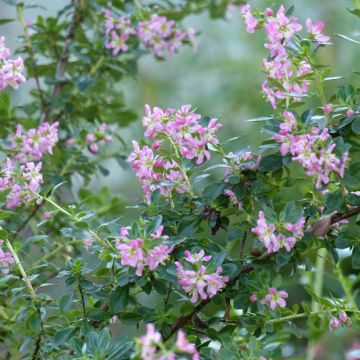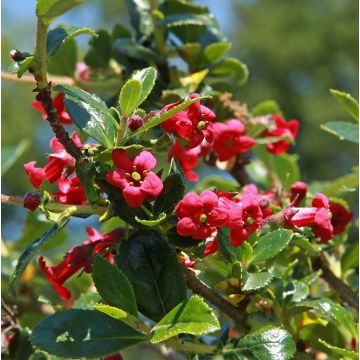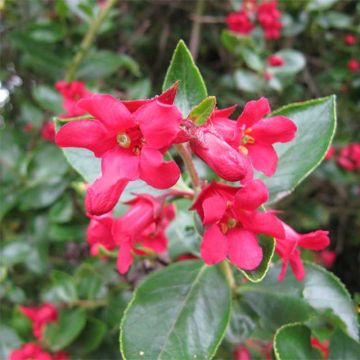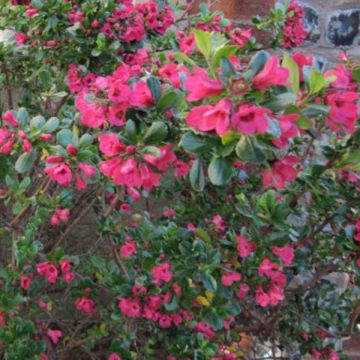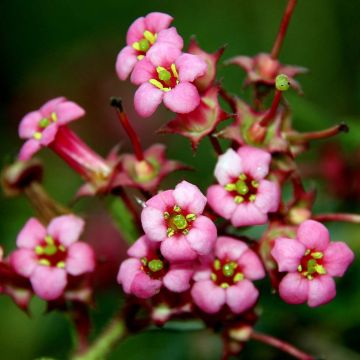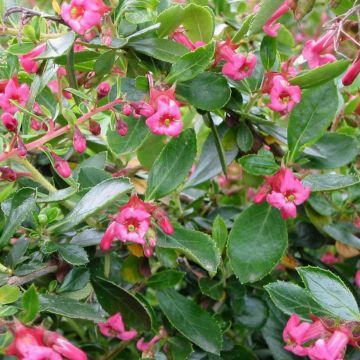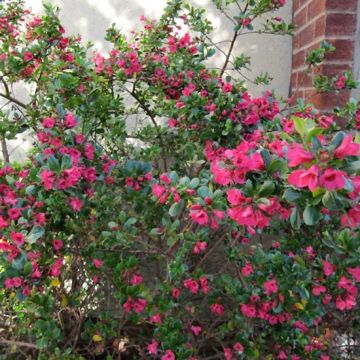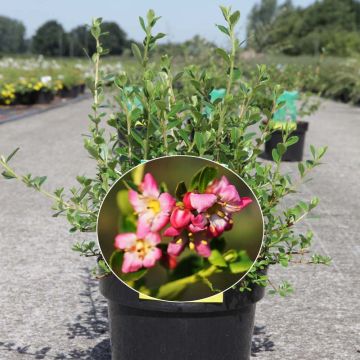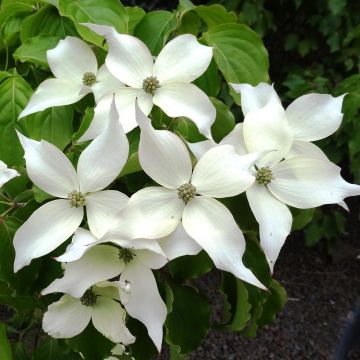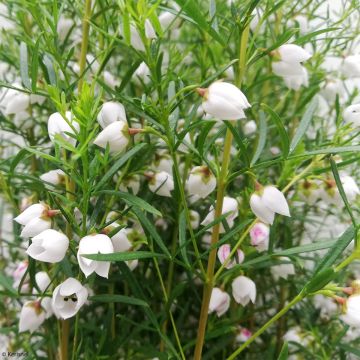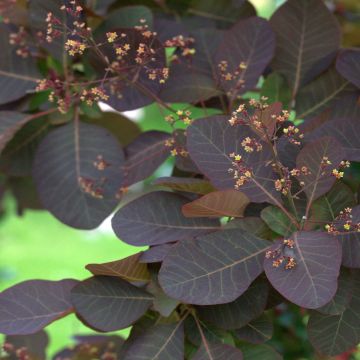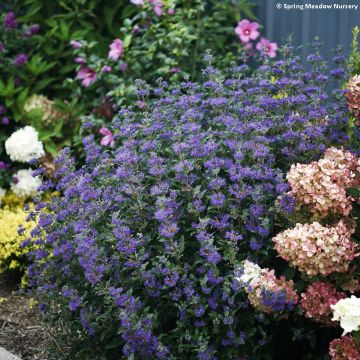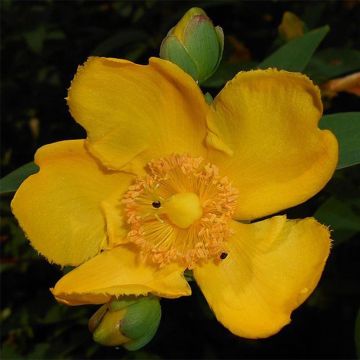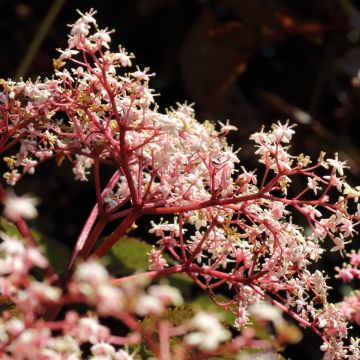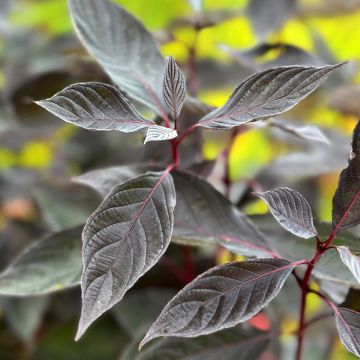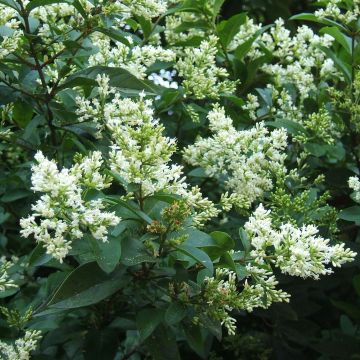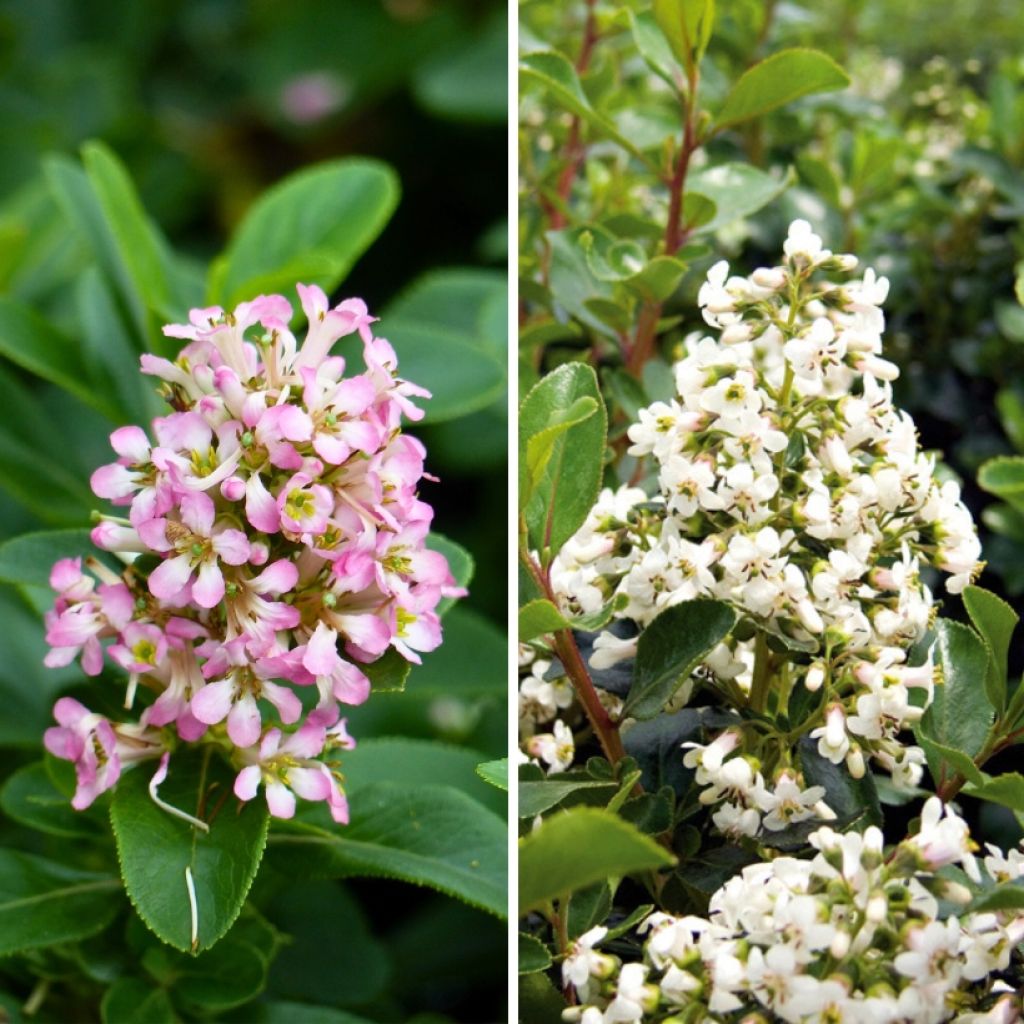

Duo of Escallonias
Duo of Escallonias
Escallonia Iveyi, Pink Elle 'Lades'
This item cannot be shipped to the selected country
Delivery charge from €5.90
More information
Schedule delivery date,
and select date in basket
This plant carries a 24 months recovery warranty
More information
We guarantee the quality of our plants for a full growing cycle, and will replace at our expense any plant that fails to recover under normal climatic and planting conditions.
From €5.90 for pickup delivery and €6.90 for home delivery
Express home delivery from €8.90.
Does this plant fit my garden?
Set up your Plantfit profile →
Collection items (2 plants)
Description
This Duo of Escallonias brings together two excellent varieties of hybrid Escallonia, an ideal choice for discovering these evergreen bushes which are perfectly adapted to mild coastal climates. 'Iveyi' is a vigorous hedge bush that produces lightly scented white flowers, while 'Pink Elle', with its compact growth and pink flowers, is a decorative plant that is easy to shape, perfect in a pretty pot on the terrace or in a low border. They can be grown in full sun or partial shade, in any well-drained soil that is not too chalky.
The duo consists of:
1 Escallonia 'Iveyi': a bushy shrub reaching 2.50 m in all directions, with gracefully arching branches, flowering in June-July and then again in September. It is hardy down to -10 °C once mature and can be grown in a large container, allowing it to be overwintered in colder regions.
1 Escallonia laevis 'Pink Elle': an adorable small shrub reaching 80 cm in all directions. It is easy to manage its size with appropriate pruning in height or width, perfect for the terrace or a small garden. From June-July to September-October, it is adorned with panicles of pink flowers streaked with white. This drought-tolerant variety is hardy down to -12°C once established.
You can plant these escallonias directly in the ground in milder regions. Elsewhere, it is better to grow them in a large container (30 to 40 litres) to protect them from severe frost. In areas with borderline hardiness, it is best to plant in March. In Mediterranean climates, on the other hand, planting in October is recommended. In any case, they should be grown in loose, fairly light, well-drained soil, preferably not chalky. The 'Iveyi' variety is best used in a hedge or shrub border with other evergreen hedge plants, with a spacing of 1.50 m between each plant. Escallonia 'Pink Elle' can be placed in front of the hedge or border, mixed with rockroses, a creeping ceanothus 'Blue Diamond', or a small Mexican orange tree like 'White Dazzler'. In this case, space the shrubs 70 to 80 cm apart.
Report an error about the product description
Plant habit
Flowering
Foliage
Botanical data
Escallonia
Iveyi, Pink Elle 'Lades'
Escalloniaceae
Cultivar or hybrid
Other Escallonias
Planting and care
Escallonia is best planted in spring in the north and early autumn in the south. It adapts to any soil that is sufficiently deep and properly drained, even slightly chalky. Choose a sunny or semi-shaded (in hot and dry climates) exposure. It can withstand sea spray, but not cold winter winds. A mature plant can endure brief frosts of around -10 °C, while young and recently planted specimens are a bit more sensitive. Once well-rooted, it tolerates summer drought well. Apply rose fertiliser in spring. Mulch the base in winter. It does not like stagnant moisture, especially in winter. If the soil is excessively chalky, it may suffer from chlorosis.
When planting in a hedge, space the Escallonia 80 cm to 1.50 m apart depending on the size of the varieties. Trim them to one-third of their height in the first few years during their establishment so that they grow compactly and densely. In a hedge, prune branches that disrupt symmetry once it has reached the desired height. You can trim it into a ball shape. In colder regions, plant it in a sheltered position, to the south against a wall or to the west, at the back of a bed or in a hedge.
Planting period
Intended location
Care
This item has not been reviewed yet - be the first to leave a review about it.
Summer-flowering shrubs
Haven't found what you were looking for?
Hardiness is the lowest winter temperature a plant can endure without suffering serious damage or even dying. However, hardiness is affected by location (a sheltered area, such as a patio), protection (winter cover) and soil type (hardiness is improved by well-drained soil).

Photo Sharing Terms & Conditions
In order to encourage gardeners to interact and share their experiences, Promesse de fleurs offers various media enabling content to be uploaded onto its Site - in particular via the ‘Photo sharing’ module.
The User agrees to refrain from:
- Posting any content that is illegal, prejudicial, insulting, racist, inciteful to hatred, revisionist, contrary to public decency, that infringes on privacy or on the privacy rights of third parties, in particular the publicity rights of persons and goods, intellectual property rights, or the right to privacy.
- Submitting content on behalf of a third party;
- Impersonate the identity of a third party and/or publish any personal information about a third party;
In general, the User undertakes to refrain from any unethical behaviour.
All Content (in particular text, comments, files, images, photos, videos, creative works, etc.), which may be subject to property or intellectual property rights, image or other private rights, shall remain the property of the User, subject to the limited rights granted by the terms of the licence granted by Promesse de fleurs as stated below. Users are at liberty to publish or not to publish such Content on the Site, notably via the ‘Photo Sharing’ facility, and accept that this Content shall be made public and freely accessible, notably on the Internet.
Users further acknowledge, undertake to have ,and guarantee that they hold all necessary rights and permissions to publish such material on the Site, in particular with regard to the legislation in force pertaining to any privacy, property, intellectual property, image, or contractual rights, or rights of any other nature. By publishing such Content on the Site, Users acknowledge accepting full liability as publishers of the Content within the meaning of the law, and grant Promesse de fleurs, free of charge, an inclusive, worldwide licence for the said Content for the entire duration of its publication, including all reproduction, representation, up/downloading, displaying, performing, transmission, and storage rights.
Users also grant permission for their name to be linked to the Content and accept that this link may not always be made available.
By engaging in posting material, Users consent to their Content becoming automatically accessible on the Internet, in particular on other sites and/or blogs and/or web pages of the Promesse de fleurs site, including in particular social pages and the Promesse de fleurs catalogue.
Users may secure the removal of entrusted content free of charge by issuing a simple request via our contact form.
The flowering period indicated on our website applies to countries and regions located in USDA zone 8 (France, the United Kingdom, Ireland, the Netherlands, etc.)
It will vary according to where you live:
- In zones 9 to 10 (Italy, Spain, Greece, etc.), flowering will occur about 2 to 4 weeks earlier.
- In zones 6 to 7 (Germany, Poland, Slovenia, and lower mountainous regions), flowering will be delayed by 2 to 3 weeks.
- In zone 5 (Central Europe, Scandinavia), blooming will be delayed by 3 to 5 weeks.
In temperate climates, pruning of spring-flowering shrubs (forsythia, spireas, etc.) should be done just after flowering.
Pruning of summer-flowering shrubs (Indian Lilac, Perovskia, etc.) can be done in winter or spring.
In cold regions as well as with frost-sensitive plants, avoid pruning too early when severe frosts may still occur.
The planting period indicated on our website applies to countries and regions located in USDA zone 8 (France, United Kingdom, Ireland, Netherlands).
It will vary according to where you live:
- In Mediterranean zones (Marseille, Madrid, Milan, etc.), autumn and winter are the best planting periods.
- In continental zones (Strasbourg, Munich, Vienna, etc.), delay planting by 2 to 3 weeks in spring and bring it forward by 2 to 4 weeks in autumn.
- In mountainous regions (the Alps, Pyrenees, Carpathians, etc.), it is best to plant in late spring (May-June) or late summer (August-September).
The harvesting period indicated on our website applies to countries and regions in USDA zone 8 (France, England, Ireland, the Netherlands).
In colder areas (Scandinavia, Poland, Austria...) fruit and vegetable harvests are likely to be delayed by 3-4 weeks.
In warmer areas (Italy, Spain, Greece, etc.), harvesting will probably take place earlier, depending on weather conditions.
The sowing periods indicated on our website apply to countries and regions within USDA Zone 8 (France, UK, Ireland, Netherlands).
In colder areas (Scandinavia, Poland, Austria...), delay any outdoor sowing by 3-4 weeks, or sow under glass.
In warmer climes (Italy, Spain, Greece, etc.), bring outdoor sowing forward by a few weeks.



































